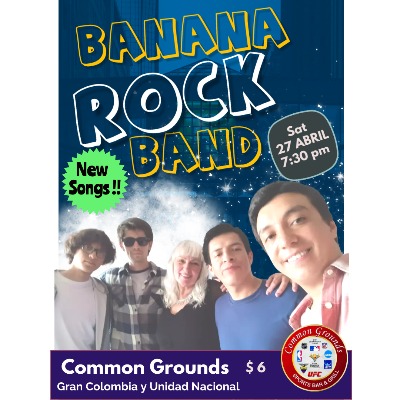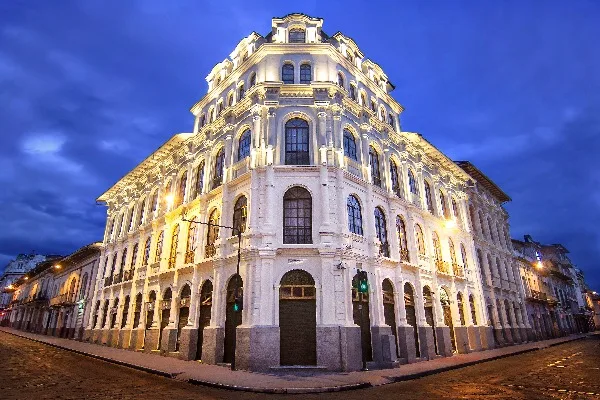Cuenca poses pedestrian challenges but they can’t compare to Delhi and Hanoi
By Kris Fischer
I look to my left. A bus careening on two wheels and belching diesel fumes bears down on me. I leap backwards just in time. My fellow pedestrians who have stayed safely curbside look at me with raised eyebrows as if to say, “Silly gringa! She really thinks that little green guy on the traffic light means she can cross safely? How has she survived this long?”
It’s just another day navigating the streets of Cuenca, Ecuador.

Pedestrians and vehicles in close proximity in Cuenca.
I guess it’s all relative, trying to figure out the unspoken rules of the road in different countries. Twenty years ago, when I lived in India, I learned that rules vary from country to country. I did most of my Indian traveling in the back of Delhi’s motor-rickshaws. They’re a motorcycle, u-haul hitched to a two-person chair. It’s India’s version of the U.S.’s 1960’s Corvair — unsafe at any speed. There are no lane lines, rules, traffic lights, or limits as to who or what shares the road. Elephants sashay anywhere they please as do sacred cows, pigs, goats, chickens, and camels. In Hinduism, all animals are free range.
Carnivalesque buses in rainbow hues, sporting gold tassels, tinkling silver bells, and statues of the gods Shiva and Ganesh, zoom along, stop and start in irregular spurts. Appearing out of nowhere, I’d see a kid kicking a soccer ball of taped-together scraps of trash, a push cart full of mangoes, or a crippled beggar. Occasionally even, we’d swerve around a dead body carefully surrounded by rocks waiting for the suitable caste to remove it. Black and yellow Ambassador cabs flashed in and out of the road throng, going fast and battling to arrive first in the turn lanes. Honking, hawking, and gear grinding are at crescendo pitch the entire trip.
Smells surrounded me as well as sound. Overripe mangoes, diesel, urine, jasmine, curry, and tamarind mingle together in good and bad ways. Crossing a street in Delhi? Maybe on the back of an elephant. Maybe never.

Think traffic is bad in Cuenca? Check out Delhi.
On the other hand, a more recent trip to Vietnam presents a whole new set of road rules. With Asian-like attention to detail, tourist brochures in Hanoi advise you how to cross their crowded and chaotic old, city streets. At one time these streets were filled with bicycles moving at a pedaling pace. Now, they’re jammed with souped-up motor scooters and motorcycles that buzz loudly, four abreast. The female riders are dressed like fashionable, Ninja warriors with surgical masks of red silk and body suits in Benetton plaid. One wonders about pollution.
The tourist bureau recommends you step out into the street and continue moving forward. Whatever you do, NEVER step back to the curb. The drivers will curve around you. They’ll never anticipate you stepping backwards … and don’t stop. The first vehicular curve-around experience will send shivers down your spine, but resist your Western instinct to step backwards.

Watch out for the motor scooters in Hanoi.
The streets are narrow in Hanoi, so the curb-to-curb terror is short-lived, although you’ll have to navigate through the endless rows of parked motorcycles to reach the sidewalk. They are lined up neatly with just enough room for a tiny Asian to slip by. We Westerners have to squeeze our way around the motorcycles, hoping they don’t topple like dominoes.
With these memories in mind, I feel petty to be complaining about Cuenca traffic, but it does have some road rules which I have yet to fully understand. One of these is driving speed. Most Cuencanos are by nature laid back and calm, but put them behind the wheel of a car and some become hell-bent road demons. All of a sudden getting there, and getting there as fast as possible, becomes life-defining for them.
Go ahead and step off the curb. I swear, the car that’s three blocks away will speed up and as you reach the far curb and another car, still a block away, will honk aggressively as if to say, “Yeh? I could have gotten you, but I decided to show mercy this time.”
Curbs are another problem when crossing streets. Some are a foot high, designed apparently for the next hundred-year flood or for all those six-foot-eight Cuencanos. Maybe it’s just foresighted city planning, anticipating the next fifty years of repaving?

Remember to look down when you’re walking.
In some cases there is no curb at all, such as at the top of the Escalinata and Hermano Miguel, where the curb is flush with the street. You come panting up the stairs and find yourself inches away from a smoking bus or speeding cab. Neither of you is sure where the sidewalk ends and the street begins, but everyone knows the bigger one has the right of way.
Timing of the traffic lights can also be problematic. In front of McDonalds, you cross from Parque de la Madre following instructions from the dancing green man, then, halfway across, you notice there’s the red man saying stop because cars are turning the corner at breakneck speed while you are sucking in your stomach standing on a painted white median line with cars whizzing by. Don’t trust the little green traffic man.
I’m beginning to feel that the new streetlights and crosswalks are only a suggestion. Recently I saw a policewoman with an orange vest ablaze with “Trafico” spelled out across it blatantly ignore the red light and zip across an El Centro street. If the enforcers jaywalk, may we?
To complicate pedestrian trips, there are strange obstructions on the sidewalk. In unexpected and unexplainable places, you find pylons, little circular mounds of concrete, sticking up on the pavement. They are just tall enough to be tripped over but not seen.
You also need to keep your eyes up to avoid metal, mid-level trash baskets attached to residential walls. Full of trash, they are easy to spot, but left down and not hitched up level with the wall they can deliver quite a bang.
Another hazard are curb cuts: unanticipated, they can send you rolling into the street with a nasty twisted ankle. Your eyes need to be roving cameras to keep you safe from the up-and-down hazards of Cuenca sidewalks and streets.
Like my Western obsession with being on time, maybe my street-crossing mentality will eventually meld with that of Cuencanos who scurry confidently across the street, trusting their fellow Cuencanos to respect their passage, regardless of traffic lights, cops, or crosswalks. After all, the few local street hazards can’t compare to the craziness of Hanoi or Delhi.
Next month I plan on buying a car and joining the road warriors. This may give me a whole different perspective on road rules.
For more on the pleasures and dangers of walking in Cuenca, click here.
_____________________
Kris Fischer is retired and writing, after fifteen years of teaching writing in Idaho. She has five grandchildren in Brooklyn, New York and Filer, Idaho. Her husband and she divide their time between Montana, Maine and Ecuador.
This article originally appeared in the January 27 issue of Cuenca Dispatch.


















